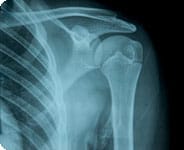Shoulder Cartilage Damage from a Pain Pump
Arthroscopic shoulder surgery is a minimally invasive procedure which is performed through a small incision to reduce the risk of complications and improve recovery time. Following the procedure, some doctors have used shoulder surgery pain pumps to deliver medication directly into the joint to manage post-surgical pain.
Please note that the lawyers at Saiontz & Kirk, P.A. are no longer taking on new cases involving Paim Pumps. The content on this page is provided for informational purposes only.
Recent studies have linked the use of these pain pumps after arthroscopic shoulder surgery to the development of a rare condition which causes a permanent deterioration of shoulder cartilage. The makers of the disposable devices failed to warn patients and the medical community about this possible complication, which has caused many people to suffer serious and permanent shoulder problems.
The lawyers at Saiontz & Kirk, P.A. were previously investigating potential lawsuits for cartillage damage caused by the use of arthroscopic shoulder surgery pain pumps. All cases are reviewed on a contingency fee basis, which means that there are no fees or expenses unless a recovery is obtained.
New cases are no longer being accepted by Saiontz & Kirk, P.A. This page is maintained for informational purposes only.
SHOULDER ARTHROSCOPY PAIN MEDICATION PUMPS
Arthroscopic surgery has gained popularity in recent years since it allows for a more efficient and timely recovery than open shoulder surgery, which exposes the tissue to infection. The procedure involves the placement of a small tube containing a camera and operating instruments through a small incision in the skin.
While the surgery is minimally invasive, it can still result in a significant amount of pain at the site of the surgery following the procedure. The pain can last for several days and most doctors prescribe oral pain medications to help manage the discomfort. However, many doctors have elected to use an intra-articular shoulder surgery pump to infuse a combination of bupivacain and epinephrine directly into the joint instead of prescribing narcotic pain killers.
The use of a shoulder surgery pain pump following shoulder arthroscopy has been linked to a risk of developing postarthroscopic glenohumeral chondrolysis, also referred to as PAGCL. The painful disorder causes a permanent deterioration of shoulder cartilage which could lead to the need for a complete shoulder joint replacement.
Typically an arthroscopic shoulder surgery recovery allows the patient to begin gradually increasing the use of their arm within a few months of the procedure. As a result of cartilage damage caused by shoulder surgery pain pumps, some individuals may experience a new onset of pain between 3 and 12 months after the arthroscopic surgery, which becomes more noticeable as the shoulder is used more.
Symptoms of PAGCL cartilage loss after a shoulder repair could include:
- Increased shoulder pain whether the shoulder is in motion or at rest
- Shoulder joint clicking, popping or grinding
- Stiffness or Weakness of the shoulder
- Decreased shoulder range of motion
SHOULDER SURGERY LAWSUITS
Saiontz & Kirk, P.A. represented individuals nationwide who are pursuing shoulder surgery pain pump lawsuits as a result of the cartilage complications. If you, a friend or family member have experienced shoulder problems after arthroscopy and received a pain pump, request a free consultation and claim evaluation. Our attorneys can review the circumstances surrounding the injury and help determine if you may qualify for a claim. There are no fees or expenses unless a recovery is obtained.
New cases are no longer being accepted by Saiontz & Kirk, P.A. This page is maintained for informational purposes only.

